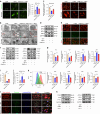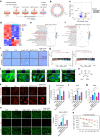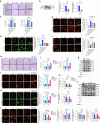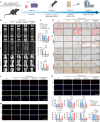Piezo1 channel exaggerates ferroptosis of nucleus pulposus cells by mediating mechanical stress-induced iron influx
- PMID: 38553442
- PMCID: PMC10980708
- DOI: 10.1038/s41413-024-00317-9
Piezo1 channel exaggerates ferroptosis of nucleus pulposus cells by mediating mechanical stress-induced iron influx
Abstract
To date, several molecules have been found to facilitate iron influx, while the types of iron influx channels remain to be elucidated. Here, Piezo1 channel was identified as a key iron transporter in response to mechanical stress. Piezo1-mediated iron overload disturbed iron metabolism and exaggerated ferroptosis in nucleus pulposus cells (NPCs). Importantly, Piezo1-induced iron influx was independent of the transferrin receptor (TFRC), a well-recognized iron gatekeeper. Furthermore, pharmacological inactivation of Piezo1 profoundly reduced iron accumulation, alleviated mitochondrial ROS, and suppressed ferroptotic alterations in stimulation of mechanical stress. Moreover, conditional knockout of Piezo1 (Col2a1-CreERT Piezo1flox/flox) attenuated the mechanical injury-induced intervertebral disc degeneration (IVDD). Notably, the protective effect of Piezo1 deficiency in IVDD was dampened in Piezo1/Gpx4 conditional double knockout (cDKO) mice (Col2a1-CreERT Piezo1flox/flox/Gpx4flox/flox). These findings suggest that Piezo1 is a potential determinant of iron influx, indicating that the Piezo1-iron-ferroptosis axis might shed light on the treatment of mechanical stress-induced diseases.
© 2024. The Author(s).
Conflict of interest statement
The authors declare no competing interests.
Figures







Similar articles
-
Mechanical overloading induces GPX4-regulated chondrocyte ferroptosis in osteoarthritis via Piezo1 channel facilitated calcium influx.J Adv Res. 2022 Nov;41:63-75. doi: 10.1016/j.jare.2022.01.004. Epub 2022 Jan 11. J Adv Res. 2022. PMID: 36328754 Free PMC article.
-
Selenium-SelK-GPX4 axis protects nucleus pulposus cells against mechanical overloading-induced ferroptosis and attenuates senescence of intervertebral disc.Cell Mol Life Sci. 2024 Jan 22;81(1):49. doi: 10.1007/s00018-023-05067-1. Cell Mol Life Sci. 2024. PMID: 38252317 Free PMC article.
-
PIEZO1-GPX4 Axis Mediates Mechanical Stress-Induced Vertebral Growth Plate Dysplasia via Ferroptosis Activation.Adv Sci (Weinh). 2025 Jul 26:e02052. doi: 10.1002/advs.202502052. Online ahead of print. Adv Sci (Weinh). 2025. PMID: 40714837
-
Role of the mechanosensitive piezo1 channel in intervertebral disc degeneration.Clin Physiol Funct Imaging. 2023 Mar;43(2):59-70. doi: 10.1111/cpf.12798. Epub 2022 Dec 8. Clin Physiol Funct Imaging. 2023. PMID: 36400723 Review.
-
Targeting Ferroptosis Holds Potential for Intervertebral Disc Degeneration Therapy.Cells. 2022 Nov 5;11(21):3508. doi: 10.3390/cells11213508. Cells. 2022. PMID: 36359904 Free PMC article. Review.
Cited by
-
The landscape of cell lineage tracing.Sci China Life Sci. 2025 Jul;68(7):1941-1963. doi: 10.1007/s11427-024-2751-6. Epub 2025 Feb 28. Sci China Life Sci. 2025. PMID: 40035969 Review.
-
Electric currents in disc health: The role of ion channels in intervertebral disc pathophysiology.J Orthop Translat. 2025 Jun 19;53:126-137. doi: 10.1016/j.jot.2025.06.007. eCollection 2025 Jul. J Orthop Translat. 2025. PMID: 40606846 Free PMC article. Review.
-
The emerging role of Piezo1 in the musculoskeletal system and disease.Theranostics. 2024 Jun 24;14(10):3963-3983. doi: 10.7150/thno.96959. eCollection 2024. Theranostics. 2024. PMID: 38994033 Free PMC article. Review.
-
RAS signaling pathway is essential in regulating PIEZO1-mediated hepatic iron overload in dehydrated hereditary stomatocytosis.Am J Hematol. 2025 Jan;100(1):52-65. doi: 10.1002/ajh.27523. Epub 2024 Nov 18. Am J Hematol. 2025. PMID: 39558179 Free PMC article.
-
GATA6 Facilitates Progression of Intervertebral Disc Degeneration by Regulating Ferroptosis via Targeting TLR2/AKR1C3.Int J Biol Sci. 2025 Jan 13;21(3):1174-1186. doi: 10.7150/ijbs.102776. eCollection 2025. Int J Biol Sci. 2025. PMID: 39897029 Free PMC article.
References
MeSH terms
Substances
Grants and funding
- 81874022/National Natural Science Foundation of China (National Science Foundation of China)
- 82172483/National Natural Science Foundation of China (National Science Foundation of China)
- 82073437/National Natural Science Foundation of China (National Science Foundation of China)
- 82073437/National Natural Science Foundation of China (National Science Foundation of China)
- 82272548/National Natural Science Foundation of China (National Science Foundation of China)
- 82072435/National Natural Science Foundation of China (National Science Foundation of China)
- 81930070/National Natural Science Foundation of China (National Science Foundation of China)
- 82102522/National Natural Science Foundation of China (National Science Foundation of China)
- 82072478/National Natural Science Foundation of China (National Science Foundation of China)
- ZR202102210113/Natural Science Foundation of Shandong Province (Shandong Provincial Natural Science Foundation)
- ZR2020YQ54/Natural Science Foundation of Shandong Province (Shandong Provincial Natural Science Foundation)
- tsqn202211317/Taishan Scholar Project of Shandong Province
LinkOut - more resources
Full Text Sources
Miscellaneous

